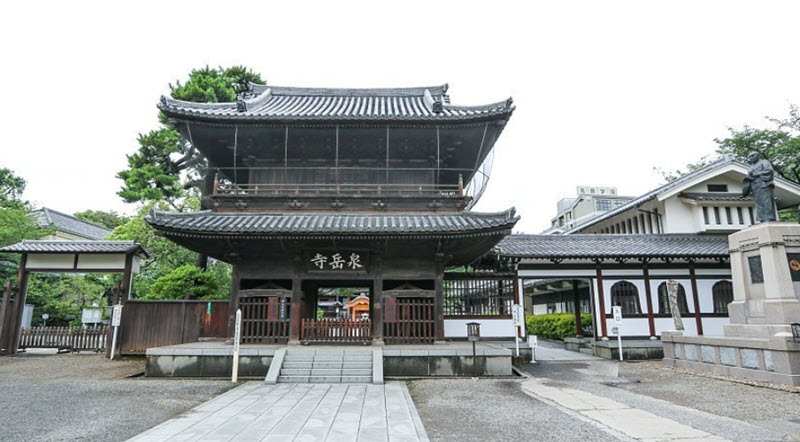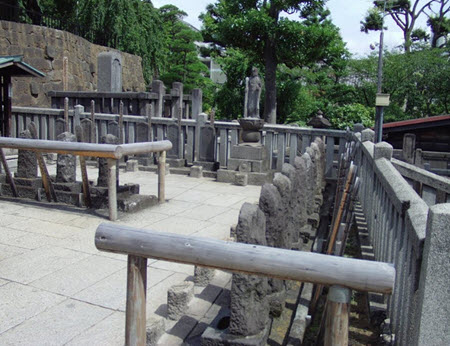Contents
The final resting place for the 47 ronin, and their master Asano, is the grounds of the Sengaku-ji temple in Tokyo.

After the ronin had killed the court official Kira as revenge for master Asano’s death, they washed Kira’s head in a well and placed it at the altar by Asano’s tomb at the Sengaku-ji temple. The head was not left there for long however, as Kira’s son quickly sent two servants to retrieve it.
46 of the ronin were sentenced to committ seppuko, which they did on the 4th of February, 1703. They were buried next to their master. The 47th ronin was pardoned by the Shogun and lived a long life. When he finally died at the age 87, he was buried with the other 46 ronin.
Ever since the Genroku era, when the revenge of the 47 ronin took place, people have been coming to the graves of the ronin to pray and show their veneration. Each year on 14 December, the day the ronin avenged their master in 1702, a festival is held at the temple to commemorate the event.
Visiting the Sengaku-ji temple
The Sengaku-ji temple is located in the neighborhood Takanawa, which is a part of the special ward Minato-ku in Tokyo. The closests railway station is the one named after the temple: Sengakuji Station. The large Shinagawa Station, which is an important travel hub, is also fairly near.
Sengakuji Station
Sengakuji Station (泉岳寺駅 Sengakuji-eki) is operated by the Tokyo Metropolitan Bureau of Transportation, but also serves as the northern terminus of the Keikyu Main Line (operated by Keikyu).
Sengakuji Station is served by the following lines:
- Toei Asakusa Line (through service to Keisei Oshiage Line, Keisei Higashi-Narita Line and Shibayama Railway Line)
- Keikyu Main Line (through service to Keikyu Airport Line and Keikyu Kurihama Line)
A lot of objects related to the 47 ronin are preserved in the temple, including clothes and the armour that they wore on the day of killing Kira. After bringing Kira’s head to the temple, the 46 ronin (one had been sent away as a messenger to Asano’s home region) donated their belongings to the temple before turning themselves in to the authorities.

The garves of the 47 ronin at Sengaku-ji temple
The armour their wore were home-made, since purchasing armour could have drawn attention to their secret plan of killing Kira.
The drum used to coordinate the attack on Kira’s mansion is still in the temple, and so is the whistle that were blewn to signal that Kira had been apprehended.
The temple also holds the banner that the ronin posted during their attack, and the receipt that a temple priest wrote out and Kira’s son’s servants had to sign to retrieve the head.
Several original letters related to the event is also kept in the temple.
The grave of the repenting man
A man who once ridiculed the ronin leader Ōishi and kicked him in his face is buried next to the 47 ronin and Asano.
After the death of their master Asano, the ronin dispersed, and Ōishi moved to Tokyo where he started living a life of sin and debauchary to make Kira believe that he was a lazy scoundrel who had no intention of avenging his master.
One time, when a drunken Ōishi had fallen asleep in the street, a man mocked him, spit on him and kicked his face, ridiculing him for being such a coward and not avenging his master. Simply touching the face of a samurai with your hand was considered a great offense at the time, so kicking Ōishi’s face was a much greater insult than whatever temporary physical damange it caused.
After it had been revealed that the cowardness and debauchary was just an act, and the ronin had both avenged their master and died honarably through seppuko instead of being executed like criminals, the man who had ridiculed Ōishi visited the Sengaku-ji temple where he begged for forgiveness before commmiting suicide. He was buried nex to the ronin.
The identity of the 47 rōnin
The information is written in the following order: family name / kemyō (pseudnym) / imina (real name). The English transcriptions come first, followed by the names written with Japanese signs.
- Ōishi Kuranosuke Yoshio (or Yoshitaka) (大石 内蔵助 良雄)
- Ōishi Chikara Yoshikane (大石 主税 良金)
- Hara Sōemon Mototoki (原 惣右衛門 元辰)
- Kataoka Gengoemon Takafusa (片岡 源五右衛門 高房)
- Horibe Yahei Kanamaru (or Akizane) (堀部 弥兵衛 金丸)
- Horibe Yasubei Taketsune (堀部 安兵衛 武庸)
- Yoshida Chūzaemon Kanesuke (吉田 忠左衛門 兼亮)
- Yoshida Sawaemon Kanesada (吉田 沢右衛門 兼貞)
- Chikamatsu Kanroku Yukishige (近松 勘六 行重)
- Mase Kyūdayū Masaaki (間瀬 久太夫 正明)
- Mase Magokurō Masatoki (間瀬 孫九郎 正辰)
- Akabane Genzō Shigekata (赤埴 源蔵 重賢)
- Ushioda Matanojō Takanori (潮田 又之丞 高教)
- Tominomori Sukeemon Masayori (富森 助右衛門 正因)
- Fuwa Kazuemon Masatane (不破 数右衛門 正種)
- Okano Kin’emon Kanehide (岡野 金右衛門 包秀)
- Onodera Jūnai Hidekazu (小野寺 十内 秀和)
- Onodera Kōemon Hidetomi (小野寺 幸右衛門 秀富)
- Kimura Okaemon Sadayuki (木村 岡右衛門 貞行)
- Okuda Magodayū Shigemori (奥田 孫太夫 重盛)
- Okuda Sadaemon Yukitaka (奥田 貞右衛門 行高)
- Hayami Tōzaemon Mitsutaka (早水 藤左衛門 満尭)
- Yada Gorōemon Suketake (矢田 五郎右衛門 助武)
- Ōishi Sezaemon Nobukiyo (大石 瀬左衛門 信清)
- Isogai Jūrōzaemon Masahisa (礒貝 十郎左衛門 正久)
- Hazama Kihei Mitsunobu (間 喜兵衛 光延)
- Hazama Jūjirō Mitsuoki (間 十次郎 光興)
- Hazama Shinrokurō Mitsukaze (間 新六郎 光風)
- Nakamura Kansuke Masatoki (中村 勘助 正辰)
- Senba Saburobei Mitsutada (千馬 三郎兵衛 光忠)
- Sugaya Hannojō Masatoshi (菅谷 半之丞 政利)
- Muramatsu Kihei Hidenao (村松 喜兵衛 秀直)
- Muramatsu Sandayū Takanao (村松 三太夫 高直)
- Kurahashi Densuke Takeyuki (倉橋 伝助 武幸)
- Okajima Yasoemon Tsuneshige (岡島 八十右衛門 常樹)
- Ōtaka Gengo Tadao (or Tadatake) (大高 源五 忠雄)
- Yatō Emoshichi Norikane (矢頭 右衛門七 教兼)
- Katsuta Shinzaemon Taketaka (勝田 新左衛門 武尭)
- Takebayashi Tadashichi Takashige (武林 唯七 隆重)
- Maebara Isuke Munefusa (前原 伊助 宗房)
- Kaiga Yazaemon Tomonobu (貝賀 弥左衛門 友信)
- Sugino Jūheiji Tsugifusa (杉野 十平次 次房)
- Kanzaki Yogorō Noriyasu (神崎 与五郎 則休)
- Mimura Jirōzaemon Kanetsune (三村 次郎左衛門 包常)
- Yakokawa Kanbei Munetoshi (横川 勘平 宗利)
- Kayano Wasuke Tsunenari (茅野 和助 常成)
- Terasaka Kichiemon Nobuyuki (寺坂 吉右衛門 信行)
Wooden statues of the 47 rōnin are found in the temple.
